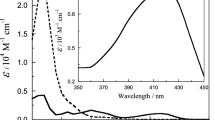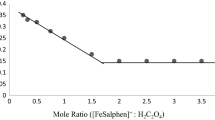Abstract
A detailed investigation of the oxidation of L-ascorbic acid (H2A) by the title complex has been carried out using conventional spectrophotometry at 510 nm, over the ranges: 0.010 ≤ [ascorbate] T ≤ 0.045 mol dm−3, 3.62 ≤ pH ≤ 5.34, and 12.0 ≤ θ ≤ 30.0 °C, 0.50 ≤ I ≤ 1.00 mol dm−3, and at ionic strength 0.60 mol dm−3 (NaClO4). The main reaction products are the bis(pyridine-2,6-dicarboxylate)cobaltate(II) ion and l-dehydroascorbic acid. The reaction rate is dependent on pH and the total ascorbate concentration in a complex manner, i.e., k obs = (k 1 K 1)[ascorbate] T /(K 1 + [H+]). The second order rate constant, k 1 [rate constant for the reaction of the cobalt(III) complex and HA−] at 25.0 °C is 2.31 ± 0.13 mol−1 dm3 s−1. ΔH ‡ = 30 ± 4 kJ mol−1 and ΔS ‡ = −138 ± 13 J mol−1 K−1. K 1, the dissociation constant for H2A, was determined as 1.58 × 10−4 mol dm−3 at an ionic strength of 0.60 mol dm−3, while the self exchange rate constant, k 11 for the title complex, was determined as 1.28 × 10−5 dm3 mol−1 s−1. An outer-sphere electron transfer mechanism has been proposed.
Similar content being viewed by others
References
A.A. Holder, S.-C. Im and T.P. Dasgupta, Transition Met. Chem., 22, 135 (1997).
L. Michaelis, J. Biol. Chem., 96, 703 (1932).
K.P. Stolyarov and I.A. Amantova, Talanta, 14, 1237 (1967).
Y. Ogata, Y. Kosugi and J. Morito, Tetrahedron, 24, 4057 (1968).
Y. Abe, S. Okada, H. Horii and S. Taniguchi, J. Chem. Soc., Perkin Trans., 715 (1987).
P. Martinez, D. Uribe, J. Zuluaga and R. van Eldik, Inorg. Chim. Acta, 136, 11 (1987).
P. Martinez and J. Zuluaga, Inorg. Chim. Acta, 146, 9 (1988).
R.D. Scurlock, D.D. Gilbert and J.N. Dekorte, Inorg. Chem., 24, 2393 (1987).
M.B. Davis, Polyhedron, 11, 285 (1992).
E.F. Kries and J. Russ, Inorg. Chem., 23, 1004 (1978).
J. Silver, H. Keypour, M.T. Wilson and M.Y. Hamed, Inorg. Chim. Acta, 125, 97 (1986).
D.A. Dixon, N.P. Sadler and T.P. Dasgupta, J. Chem. Soc., Dalton Trans., 1903 (1997).
N.H. Williams and J.K. Yandell, Aust. J. Chem., 36, 2377 (1983).
P.W. Dimmock, J. McGinnis, B.-L. Ooi and A.G. Sykes, Inorg. Chem., 29, 1085 (1990).
A.R. Mauk, C.L. Coyle, E. Bordignon and H.B. Gray, J. Am. Chem. Soc., 101, 5054 (1979).
N.H. Williams and J.K. Yandell, Aust. J. Chem., 35, 1133 (1982).
P.W. Atkins, Physical Chemistry, 4th edit., Oxford University Press, Oxford, UK, 1990, p. 858.
J.N. Brùnsted, Z. Phys. Chem., 102, 169 (1922).
R.A. Marcus, Discuss. Faraday Soc., 29, 21 (1960).
R.A. Marcus, Can. J. Chem., 37, 155 (1959).
R.A. Marcus, J. Phys. Chem., 67, 853 (1963).
D.A. Dixon, N.P. Sadler and T.P. Dasgupta, Transition Met. Chem., 20, 295 (1995).
P. Martinez, J. Zuluaga, P. Noheda and R. van Eldik, Inorg. Chim. Acta, 195, 249 (1992).
Author information
Authors and Affiliations
Rights and permissions
About this article
Cite this article
Holder, A.A., Brown, R.F.G., Marshall, S.C. et al. Mechanism of the oxidation of L-ascorbic acid by the bis(pyridine-2,6-dicarboxylate)cobaltate(III) ion in aqueous solution. Transition Metal Chemistry 25, 605–611 (2000). https://doi.org/10.1023/A:1007046125017
Issue Date:
DOI: https://doi.org/10.1023/A:1007046125017




